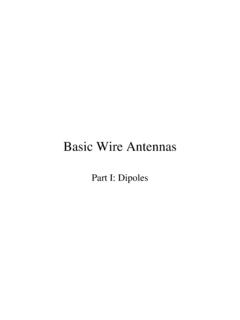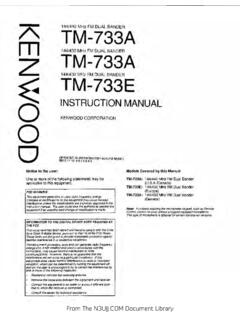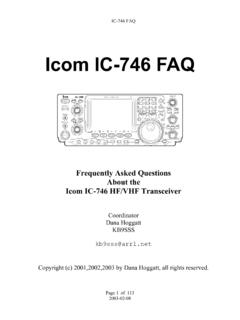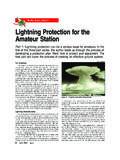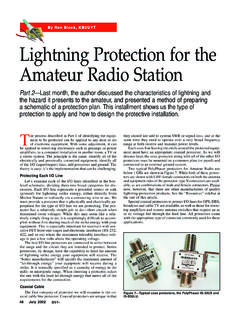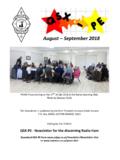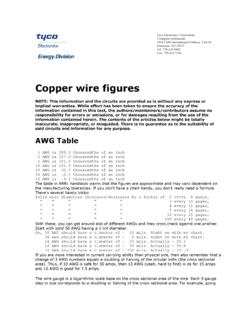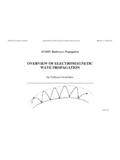Transcription of HF Radio Wave Propagation.ppt - Website of Amateur Radio ...
1 HF Radio Wave PropagationIntroduction Understanding Radio wave propagation can mean thedifference between making and missing a contact to aparticular part of the world. This presentation examines HF propagation This presentation examines HF propagation HF region spans 3 to 30 MHz. This includes the 80, 40, 30, 20, 17, 15, 12, and 10 meter bands. The only MF Amateur band, 160m, will not be discussed, norwill bands above 10 of HF propagation Characteristics of HF Radio propagation propagation is possible over thousands of miles.
2 It is highly variable. It has daily and seasonal variation, HF Radio waves may travel by any of thefollowing modes: Ground Wave Direct Wave (line-of-sight) Sky WaveGround waves In the HF region, the ground is a poor conductor andthe ground wave is quickly attenuated by ground ground wave communication is possible on 80m,butatfrequenciesabove5 MHz,thegroundwaveisbutatfrequenciesabove 5 MHz, waves Direct waves follow the line-of-sight path betweentransmitter and receiver.
3 In order for direct wavecommunication to occur, antennas at both ends of thepathhavetohavelowanglesofradiation(so theycanpathhavetohavelowanglesofradiatio n(sotheycan see each other). This is difficult to do on the lowerbands, and as a result, direct wave communication isnormally restricted to bands above 20m. Its range isdetermined by the height of both antennas and generallyless than 20 waves Sky waves are waves that leave the transmitting antennain a straight line and are returned to the earth at aconsiderable distance by an electrically charged much of the day to almost anywhere in theworld via sky Ionosphere Created by ionization of the upper atmosphereby the sun.)
4 Electricallyactiveasaresultoftheionizati on. Electricallyactiveasaresultoftheionizati on. Bends and attenuates HF Radio waves Above 200 MHz, the ionosphere becomes completely Creates most propagation phenomena observed at HF,MF, LF and VLF frequenciesThe Ionosphere Consists of 4 highly ionized regions The D layer at a height of 38 55 mi TheElayerataheightof62 75mi TheElayerataheightof62 75mi The F1 layer at a height of 125 150 mi (winter) and 160 180mi (summer) The F2 layer at a height of 150 180 mi (winter) and 240 260mi (summer)
5 The density of ionization is greatest in the F layers andleast in the D layerThe IonosphereThe Ionosphere Though created by solar radiation, it does notcompletely disappear shortly after sunset. The D and E layers disappear very quickly The F1 and F2 layers do not disappear, but mergeinto a single F layer residing at a distance of 150 250 mi above the earth. Ions recombine much faster at lower altitudes. Recombination at altitudes of 200 mi is slowslow that the F layer lasts until D-Layer Extends from 38 55 miles altitude.
6 Is created at sunrise, reaches maximum density at noon,and disappears by sunset. The D layer plays only a negative role in It acts as an attenuator, absorbing the Radio signals,rather than returning them to earth. The absorption is inversely proportional to the square ofthe frequency, severely restricting communications onthe lower HF bands during E layer Extends from 38 55 miles altitude. Is created at sunrise, reaches maximum density at noon,and disappears by sunset.
7 ItcanreturnlowerHFfrequenciestotheEarth, resultingin ItcanreturnlowerHFfrequenciestotheEarth, resultingindaytime short skip on the lower HF bands. It has very little effect on higher frequency HF radiowaves, other than to change slightly their direction F Layers The F1 layer extends from 125 150 mi (winter) and 160 180 mi (summer) TheF2layerextendsfrom150 180mi(winter)and240 TheF2layerextendsfrom150 180mi(winter)and240260 mi (summer) The F layers are primarily responsible for long-haul HFcommunications.
8 Because there is only F layer ionization throughout thehours of darkness, it is carries almost all nighttimecommunications over intercontinental Critical Frequency (fc) Whenradiowavesaretransmittedstraightupto wardstheionosphere(vertical incidence), the radiowavewillbereturnedtoearthatallfrequ enciesbelowthewavewillbereturnedtoeartha tallfrequenciesbelowthecritical frequency, (fc) . Thecriticalfrequencydepends on the degree ofionization of the ionosphere,as shown in the followingequation:1010* Maximum Usable Frequency (MUF) Generally, Radio waves leave the transmitting antenna at anglesof 0 to 30 degrees and hit the ionosphere obliquely, requiringless bending be returned to earth, thus frequencies above thecritical frequency can be returned.
9 The maximum frequency returned at a 0 takeoff angle is calledthe maximum usable frequency (MUF). The critical frequencyand the MUF are related by the following equation:and the MUF are related by the following equation: where R = earth s radius and h = height of the ionosphere: Typical MUF values: 15 40 MHz (daytime) 3 14 MHz(nighttime)21 hRRfMUFcrMaximum Usable Frequency (MUF)Hop Geometry The longest hoppossible on the HFbands isapproximately2500 miles2500 miles Longer distancesare covered bymultiple hoppropagation.
10 Whenthe refracted radiowave returns toearth, it is reflectedback up towardsthe ionosphere,which beginsanother propagation Effects Shortly after sunrise, the D and E layers are formed and the Flayer splits into two parts. The D layer acts as a selective absorber, attenuating low frequencysignals, making frequencies below 5 or 6 MHz useless during the dayfor DX work. The E and F1 layers increase steadily in intensity fromsunrise to noon and then decreases thereafter. ShortskippropagationviatheEorF1layerswhe nthelocaltimeat ShortskippropagationviatheEorF1layerswhe nthelocaltimeatthe ionospheric refraction pointis approximately noon.
